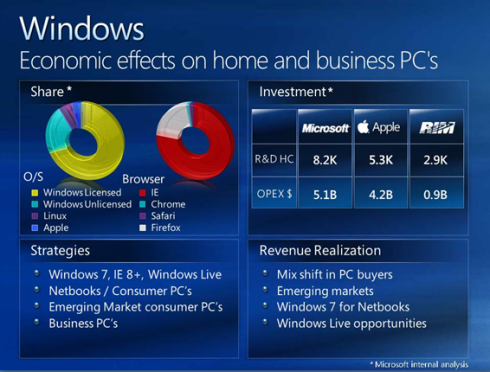

Steve Ballmer's presentation slide
from 2009 shows GNU/Linux as bigger than Apple on the desktop
ONCE in a few months we remind people that Apple is too small a player on the desktop and hardly a threat to GNU/Linux. Apple's minuscule market share outside the United States and other Western nations (where Apple is also a niche but at least an existing one) ensures that GNU/Linux remains a very relevant platform on the desktop.
While this is a good idea, it is far from being a new idea. Even if you ignore the fact that our mobile computers have had application stores for years, Linux was the first to create a centralized, graphical application for easily installing software on your computer with a single click. Beyond simple applications such as gnome-app-install, the Ubuntu Software Center was released over a year ago
That’s all Apple managed to sell in a recent quarter while the world sold 88 million PCs. That’s 4%, folks, Rather modest compared to the 7% of W3Schools hits and the 5% of NetApplications. This makes me think GNU/Linux has a much larger share than NetApplications shows or that other OS is a lot less than they show.
[...]
So, Apple can crow about its wonderful recent quarter but GNU/Linux has overtaken them in PCs and smartphones. It’s time GNU/Linux crowed a bit.
M$ is boasting of selling 240 million licences for “7ââ¬Â³ in the last year. 350 million PCs have been produced in the last year.
Comments
twitter
2010-10-24 14:45:57
Pogson credits business for the low adoption rate of Windows 7 and lack of choice for everyone but corporate purchasers for the shipping rate Microsoft is spinning. His numbers, 240/350, give the renamed hated OS a best case shipping rate of 68%. Shipping is not sales and sales is not use, so this best case translates to something considerably less in actual use. Pogson has updated his article by noting that it will take two years for Vista/Windows 7 use will not equal XP use at that rate. What would be really interesting is a chart of the Windows shipping rate fraction over the last ten years, my hunch is that it would show a continuous downward trend.
We've been here before. Vista's sales numbers fell off after it's first year and tumbled to nothing at the end of it's second. Something similar is happening to Windows 7, though they have taken advantage of dumping and fanboys to delay the drop off with channel stuffing.
The current purchase rate is channel stuffing and some fanboy use. Early adoption of Windows 7 was mostly people running away from Vista, the five percent of select markets that Vista owned flipped almost overnight to Windows 7. Recent promotion of Windows 7 by OEMs is good evidence that Microsoft managed to channel stuff them as part of their huge marketing drive to make the hated and renamed OS look like a success on it's fourth year of failure.
Mojave, Mojave, Mojave - look you really love what you hate!
Will
2010-10-24 17:03:46
"There are other areas where GNU/Linux is technically ahead of **GNU/Linux**; marketing is no such area."
That's either supposed to be Apple, or I'm confused.
Dr. Roy Schestowitz
2010-10-24 17:21:21